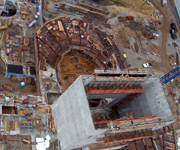 Right now the stage tower is the tallest structure at the Kauffman Center construction site, clearly visible from a car driving down Broadway. However, the huge stage tower, seen in the lower right corner of this aerial photo, will soon be hidden out of sight by steel and even more concrete.
Right now the stage tower is the tallest structure at the Kauffman Center construction site, clearly visible from a car driving down Broadway. However, the huge stage tower, seen in the lower right corner of this aerial photo, will soon be hidden out of sight by steel and even more concrete.
So what precisely will go on inside this 74-foot tall structure rising above the stage? Flying scenery, catwalks and a huge loading dock are in the works, all eagerly anticipated by two resident companies, the Kansas City Ballet and the Lyric Opera.
In the Kauffman Center’s 1,800 seat proscenium theatre, the audience will sit facing the stage and view performances through a rectangular opening, like they do at many Kansas City venues. However, most comparisons stop there.
Above the stage where the Kansas City Ballet and the Lyric Opera will perform, looms a 74-foot tall stage tower that plays a critical role in the theatrical experience. Its volume and rigging systems will allow technical crews to hang lighting, sets and other equipment directly above the stage area — and lower onto the stage as needed.
According to Michael Ferguson, project manager for Theatre Projects Consultants, the Kauffman Center has a “full-height stage tower that allows for full-height scenery to be completely flown above the stage.” This means that, in the proscenium theatre, sets as tall as 30 feet can be flown above the stage and tucked completely out of sight.
“It should expand our capacity to stage a production in cooperation with the larger opera companies,” remarks Evan Luskin, general manager of the Lyric Opera. “In the past we were often the smallest company and joint productions often had to be scaled back to accommodate our space restrictions.”
“We would like now and again to produce more of the full-length story ballets similar to our successful Romeo and Juliet last season,” shares Jeffrey Bentley, executive director of the Kansas City Ballet. “Most of our brethren companies, from whom we rent sets and costumes, almost always perform in larger halls and build their full-length productions on a scale that doesn’t work for us in the Lyric.”
At the highest level of the tower is a fully walkable rigging grid, something missing from many stage towers due to height restrictions. Technicians access this steel structure by elevator or stairs. They can then walk above the fly loft to adjust the lift lines and loft-blocks of the counterweight system. Theaters without this space have fixed, less flexible, systems.
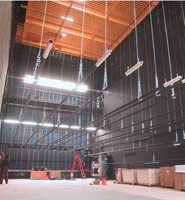 The tower also houses state-of-the-art rigging and lighting systems. Rigging (like those shown in the small stage tower to the right) allows equipment on the stage to be raised, lowered, rotated and moved from side to side. It also serves practical functions, like hanging and masking lighting and provides dramatic effect when used to move scenery and arrange draperies.
The tower also houses state-of-the-art rigging and lighting systems. Rigging (like those shown in the small stage tower to the right) allows equipment on the stage to be raised, lowered, rotated and moved from side to side. It also serves practical functions, like hanging and masking lighting and provides dramatic effect when used to move scenery and arrange draperies.
Two catwalks, called galleries, are positioned on each side of the stage house. A mid-gallery catwalk is in place specifically for automated use during a production. “This is an accommodation for modern scenic techniques that use a lot of motorized or tracking scenery,” Ferguson explains. Galleries are used to hang scenery, to feed electrical and dimming equipment and to access the counterweight fly system.
A flexible proscenium opening is another feature of this hall. The width of the stage opening can be adjusted from 40 to 50 feet. A set designer or director can adjust the proscenium opening to a particular size for a show, using movable panels. Once in place the proscenium opening appears to the audience as finished, tailored and part of the architecture. The visual height of the opening can also be adjusted.
According to Ferguson, “This makes the stage tremendously flexible. A smaller ballet, for example, won’t feel lost on the stage, while a Wagner opera will have plenty of space for the large scenery and cast.” Ferguson emphasizes that all dimensions are tailored to the size of this particular hall. “We’ve worked very hard with the architect, Moshe Safdie, to make both halls intimate, with audiences as close to performers as possible.”
Learn more about the proscenium theatre. Also read a conversation with Richard Pilbrow, theater designer with Theater Projects Consultants.
While the words “trap door” might conjure up visions of the devil rising through a small, smoky opening in a stage floor, the Kauffman Center’s trap platform system will quickly dispel that somewhat limited image.
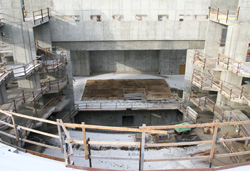 The photo to the left looks toward the proscenium theatre stage from back of the house. On the stage floor, the 32 foot by 52 foot opening for the trap platform is covered by plywood. But given its size it is easy to imagine how this large and very flexible trap system will open new doors for performances, particularly for the Lyric Opera.
The photo to the left looks toward the proscenium theatre stage from back of the house. On the stage floor, the 32 foot by 52 foot opening for the trap platform is covered by plywood. But given its size it is easy to imagine how this large and very flexible trap system will open new doors for performances, particularly for the Lyric Opera.
“The Kauffman Center’s trap platform system will be a large and modular system, made up by 4 by 4 foot and 8 by 8 foot platforms,” explains Michael Ferguson project manager for Theatre Project Consultants. The platform decks are supported from below on a system of demountable legs and beams.
A director can choose to use any number of the 56 platform openings, in a variety of configurations. The system is designed to be completely flexible, so any number of the modules can be removed at any time. For example, if a character needs to sail down a river, five or six sections in the correct places could be opened to create a river-like configuration. The boat could rise up from below and make its way on tracks placed across the opening.
Below the trap platform opening is a “trap room” that is as large as the stage opening. Wide doors below provide access for loading temporary equipment or sets. Actors will have easy access to the trap room through stairs or elevators, meeting ADA requirements.
“The last time the opera performed Wagner’s Siegfried, the singer performing Erda had to lie in wait for her entrance, literally stuffed under a false floor beneath the set,” Evan Luskin, general director of the Lyric Opera explains. “When it was time for her entrance, she had to sort of shimmy out of her crawl space — and there’s no way we could have added smoke for effect. She would have asphyxiated during the wait.”
But the next time the earth goddess appears in Kansas City she’ll do it in great style. Lifted from the bowels of the earth, Erda will appear dramatically amidst a screen of smoke, through the trap platform system in the stage floor.
For more details on the proscenium theater read:
- An interview with theatre designer Richard Pilbrow of Theater Project Consultants
- An article about the stage tower and its many features.
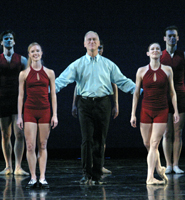 Whitener’s Vision
Whitener’s Vision
When asked his thoughts about the Kansas City Ballet’s future at the Kauffman Center, William Whitener, the Ballet’s artistic director, reached back to a childhood memory. Growing up in Seattle in the 50s, Whitener only had access to touring ballet productions and often viewed them in less-than-optimal theaters. (Photos courtesy of Steve Wilson).
“Even from the top balcony, with what appeared to be tiny dancers on stage, my interest was piqued,” Whitener shared. “Imagine the dance experiences our young people will enjoy, in a technically excellent theatre that is both intimate for the audience and expansive for the dancers,” Whitener says. “We are so fortunate that people in Kansas City are making this possible.”
The availability of two halls at the Kauffman Center (instead of one shared space at the Lyric Theatre) offers expanded programming opportunities for the center’s three resident companies — the Kansas City Ballet, the Lyric Opera and the Kansas City Symphony. For Whitener, the Kauffman Center design also opens up exciting opportunities for a greater variety in programming.
Whitener says that the larger proscenium theatre stage area will allow the company to do more full evening, narrative works, like Romeo and Juliet that the Ballet recently staged at the Music Hall. The Lyric Theatre cannot accommodate the number of dancers required on stage, nor can it handle the large sets demand by such productions.
“We can expand what we call our ‘mixed repertory’ in which we present three to four ballets in one evening,” Whitener suggests. “We’ve found this format to be a great way to introduce the medium to a newcomer and to provide the devoted follower a prismatic view of the art form.”
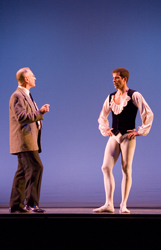 Whitener also looks forward to taking advantage of the incredible technological capacity planned for the Kauffman Center. He cites the Kansas City Rep’s applications in the recent production of Clay, in which dramatic lighting was used, rather than scenery, to support changes in setting and locale. “The Ballet can develop works with contemporary themes and issues that relate to our times and capitalize on the Kauffman Center’s range of technology, like the Rep did with Clay.” Whitener says.
Whitener also looks forward to taking advantage of the incredible technological capacity planned for the Kauffman Center. He cites the Kansas City Rep’s applications in the recent production of Clay, in which dramatic lighting was used, rather than scenery, to support changes in setting and locale. “The Ballet can develop works with contemporary themes and issues that relate to our times and capitalize on the Kauffman Center’s range of technology, like the Rep did with Clay.” Whitener says.
Whitener’s dreams extend to matinees designed for families, like one he saw recently in Moscow. “The audience had all types of family groupings, from grandparents with grandchildren to moms with daughters,” Whitener described. “And at least half of the children were boys. The theatre was completely quiet except for an occasional rustle and whisper as parents used the special children’s program to connect the Russian folk tale characters with the dancers on stage.”
As the kids spilled out into the avenue, Whitener saw them skipping and dancing. “Making that kind of immediate connection is what every artist dreams of,” Whitener says. “It’s utopian.”
Whitener stresses that these types of productions will not be done at the expense of the variety (or tradition) that the Ballet has developed within its repertory. However, he thinks that Todd Bolender, the Ballet’s original artistic director, would agree with the future direction being envisioned by the Ballet.
“Bolender kept his vision on the individuality of the artists, showcasing the talents of the company and expanding into some larger scale works. I’d like to think what we’re planning is also the way that Bolender would have made the leap into the new space.”
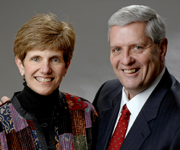
Seat Naming Campaign Extends a Legacy
Fred and Carol Logan don’t just talk about their support for the arts–they act on it. Among many other activities, Fred has been on the board of the Arts Council of Metropolitan Kansas City for five years and became its chair a year ago. On Feb. 5, Carol will complete almost three years of training to become a docent at the Nelson-Atkins Museum of Art.
So it’s not surprising that the Logan family decided to fund two seats at the Kauffman Center for the Performing Arts through the Seat Naming Campaign. “This new facility, like the Nelson, is so representative of the excellence in the arts that Kansas City offers,” says Fred Logan. “Our family definitely wants to be part of it.”
When Peggy and Terry Dunn invited the Logans to a dinner held last year to introduce the Kauffman Center to a few friends, Fred and Carol immediately knew that they wanted to get involved. “Isaac Franco, one of the architects, spoke to us and we knew that what was being built is exceptional and will really set Kansas City apart,” Carol shared recently.
While they were impressed that the building itself will be a unique, iconic structure for the region to celebrate, the Logans were more entranced by the opportunity the Kauffman Center provides to reach new audiences, including children and young people.
“We are really excited about the idea that kids from all over the region will come to the center and get to participate as audiences and, sometimes, as performers,” Fred replied when asked about the motivation for their gift. The Logans have made a direct contribution to name one seat and have signed a multi-year pledge to support a second. Contributions to the Seat Naming Campaign support the Kauffman Center’s operating endowment.
Fred Logan is a partner in Logan, Logan and Watson, LLC, a law firm based in Prairie Village. The Logans live in Leawood and know how important the arts are to the region. Fred writes a bi-weekly column for the Kansas City Business Journal and has written two columns about the Kauffman Center, stressing the iconic nature of the building as well as the importance of the educational programs it will offer.
“People, particularly young people deciding where to live, want to live in an area with great cultural amenities,” Fred emphasized. “We care about this for our children and for others considering living in our region. The arts are crucial to attracting the workforce our community needs to stay vibrant.”
Carol says that they chose to put their names and those of their three sons, Andy,
Sam and Jack on the nameplates that will appear on the seats. “We hope that having their names within the building will build their interest in the arts, too.”
“I just think it’s going to have a profoundly beneficial impact on all the arts organizations in the region,” says Fred. “The Kauffman Center will definitely raise the visibility of the arts in our region, an important goal of the Arts Council.”
Learn more about the Seat Naming Campaign and how you can get involved.
For more information, message contact@kauffmancenter.org.
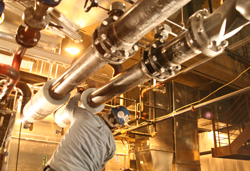 Construction Continues in the Cold
Construction Continues in the Cold
Passers-by can readily see steel installers braving Kansas City’s lowest temperatures to erect the Kauffman Center’s steel skeleton. However, it’s difficult to see if anything else is happening on site during these often harsh months.
Below the two performance halls, in the areas called “back of house” in theater parlance, more than 25 people are hard at work. And while their work is focused on infrastructure we often take for granted, things like acoustics and audience comfort are constantly driving decisions and construction.
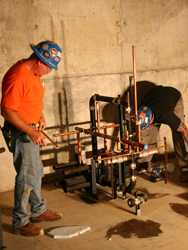 To allow interior work to move ahead simultaneously with steel installation, a supplemental waterproofing plan was developed. This means that utility spaces below street level remain dry and crews can work there and install sensitive equipment even in winter weather. In addition, elevator and escalator openings have been enclosed to keep out rainwater, snow and ice. “Generally waterproofing is a much later step in construction,” says Dwight Davis, mechanical-electrical coordinator for JE Dunn Construction. “But our approach has allowed work to move forward in multiple places at the site.”
To allow interior work to move ahead simultaneously with steel installation, a supplemental waterproofing plan was developed. This means that utility spaces below street level remain dry and crews can work there and install sensitive equipment even in winter weather. In addition, elevator and escalator openings have been enclosed to keep out rainwater, snow and ice. “Generally waterproofing is a much later step in construction,” says Dwight Davis, mechanical-electrical coordinator for JE Dunn Construction. “But our approach has allowed work to move forward in multiple places at the site.”
As a result, workers are installing ductwork and equipment needed to drive the Kauffman Center’s displacement air system, which has been designed to reduce any sounds from heating or cooling being pumped into the halls. The ductwork is sized as large as possible to maximize the volume of air delivered and to reduce its velocity (and hence, any noise it might make). “Some of the ductwork is large enough to drive a car through,” says Davis.
Special steps are even being taken within the ductwork. In most buildings, ductwork is installed, then insulated. In the Kauffman Center, the inside of the ductwork is being insulated. As a result, any sound generated in the ducts (such as air rounding a corner) will be deadened.
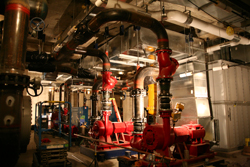 Chillers, boilers and fans can develop annoying sounds. “Every pump, every fan, every machine that has some mechanical moving part has a degree of isolation that is rarely seen on a project,” says Davis.
Chillers, boilers and fans can develop annoying sounds. “Every pump, every fan, every machine that has some mechanical moving part has a degree of isolation that is rarely seen on a project,” says Davis.
In the Kauffman Center equipment like this is being mounted on spring isolators so that if they do move or shake, the building itself will not absorb the sound. Think of your washing machine getting out of balance. The loud noise comes from the machine reverberating against the floor (or even walls). This won’t happen with Kauffman Center equipment, as it has been “spring hung.”
No potential source of sounds that might interrupt performances has been missed in the planning for these halls. Even electrical transformers, which can “hum” a bit, are being isolated as far as possible from performance areas. “The only humming we want to hear is from performers on stage and audience members as they leave, tunes running happily through their heads,” says Jane Chu, president and CEO of the Kauffman Center.